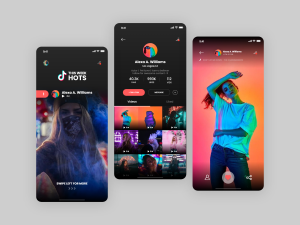
Introduction
The media and entertainment industry has always been at the forefront of technological innovation, and blockchain technology is no exception. With its potential to revolutionize how content is created, distributed, and consumed, blockchain is reshaping the landscape of media and entertainment. This article explores how blockchain technology is transforming this sector, the benefits it offers, the challenges it faces, and its future potential.
Understanding Blockchain Technology

Blockchain is a decentralized digital ledger that records transactions across multiple computers in a way that ensures the security and transparency of data. Unlike traditional databases that are controlled by a single entity, blockchain operates on a peer-to-peer network, making it resistant to tampering and fraud. This technology is the backbone of cryptocurrencies like Bitcoin but has far-reaching applications beyond finance.
User Data Privacy
Right now, media companies collect and sell user data for advertising, which concerns many people. Blockchain allows users to control their own data. Instead of companies deciding what to do with your information, you choose what to share, making privacy more secure.
Transparent Revenue Distribution
One problem in media today is that creators don’t always know how much money they should be earning from their work. Companies often don’t provide clear reports, making it hard to track income. With blockchain, all transactions are visible to everyone, making revenue streams transparent. This way, creators can see exactly where their earnings come from and know they’re being paid fairly.
Enhancing Content Creation
Blockchain is changing how content is made in the media and entertainment industry. Traditionally, creators have struggled with issues like copyright theft and losing control of their work. Blockchain helps solve these problems by giving creators a secure way to register their content. This ensures their intellectual property rights are protected, allowing them to keep control over their work.
Blockchain also makes it easier for creators to collaborate. Using smart contracts, artists can set up agreements that automatically carry out actions when specific conditions are met. This reduces the need for middlemen, speeds up the creative process, and ensures everyone is paid fairly.
Revolutionizing Content Distribution

In the past, a few big companies controlled the distribution of media content, limiting options for both creators and consumers. Blockchain is shaking up this model by enabling decentralized platforms for content distribution. These platforms let creators share their work directly with consumers, cutting out traditional middlemen.
Decentralized platforms provide more access to diverse content and empower consumers to support creators directly. Plus, blockchain makes sure creators get a fair share of the money made from their work, as all transactions are recorded in a transparent and permanent way.
Improving Monetization Models
Making money has always been a challenge in the media and entertainment industry. Blockchain offers new ways for creators and consumers to earn and spend money. One example is using cryptocurrency for micropayments, which allows consumers to pay for content as they use it instead of paying a monthly subscription.
Additionally, blockchain lets creators create their own tokens to raise funds and connect with their audience. These tokens can be used to access special content, take part in decisions, or even share in a project’s success. This not only gives creators new ways to earn money but also builds a sense of community and loyalty among their fans.
Ensuring Transparency and Security

In today’s digital world, transparency and security are very important in media and entertainment. Blockchain helps by providing a clear and permanent record of transactions, which means everyone involved in creating, sharing, and consuming content can trust the process.
Blockchain also improves security by protecting content from theft and unauthorized sharing. Through encryption and digital rights management, blockchain ensures that only authorized users can access and share content. This protects creators’ intellectual property and keeps consumers safe from fake or harmful content.
Lower Transaction Costs
In traditional media, every time someone buys a movie, music, or show ticket, companies like banks or payment processors charge fees. These extra costs affect both creators and consumers. Blockchain allows people to pay each other directly without needing a middleman. This lowers the costs, making it cheaper for fans to access content and helping creators keep more of their money.
Global Access to Content
Currently, media access can be difficult because of licensing rules or restrictions based on location. For example, some shows or music are only available in certain countries. Blockchain can remove these barriers by creating a global platform where creators can share their work with anyone, anywhere. This helps artists reach a larger audience without the limits of traditional media.
Decentralized Ownership and Rights
In traditional media, big companies like studios or record labels usually control the rights to content. This means creators, like musicians or filmmakers, don’t always have full control over their work or the money it makes. With blockchain, ownership is spread out, or decentralized. This lets creators keep more control over their content and decide how it’s used or sold, without needing big companies to manage their rights.
Fair Payments with Smart Contracts

In today’s system, payments to creators often pass through several middlemen, like publishers or agents, which reduces the amount creators receive. Blockchain uses smart contracts, which are automatic digital agreements. These smart contracts make sure creators get paid instantly and fairly whenever their content is bought or used. This removes the need for middlemen and cuts down on extra fees.
Fighting Piracy and Copyright Problems
Piracy and the unauthorized use of content are big challenges in the media industry. It can be hard to know who owns a piece of music, film, or art and how it’s being used. Blockchain helps solve this by creating a clear and secure record of ownership and transactions. This makes it easier to track and protect content, so creators get the credit and payment they deserve.
Better Fan Engagement
In traditional media, fans mostly just watch or listen to content with little direct connection to the creators. Blockchain changes this by giving fans more ways to engage with creators. For example, artists can give out tokens or rewards to fans who support them. This builds stronger communities and encourages fans to interact more with their favorite artists or shows.
The Impact of Blockchain on Media and Entertainment

1. Content Creation and Ownership
Blockchain technology enables creators to maintain ownership of their content. With smart contracts, artists can set terms for their work, ensuring they receive royalties for every transaction involving their creations. This eliminates the traditional model where intermediaries often take a significant portion of the profits, allowing creators to earn more from their efforts.
2. Fair Distribution of Royalties
The distribution of royalties in the media industry has long been a contentious issue. Blockchain provides a transparent way to track content usage and automatically distribute payments to creators. This ensures that artists, producers, and other contributors are fairly compensated for their work, fostering a more equitable environment in the industry.
3. Enhanced Transparency and Trust
Blockchain’s transparent nature helps build trust among stakeholders in the media and entertainment industry. For example, advertisers can verify that their ads are being placed in the right contexts and that views are genuine, reducing fraud and increasing accountability. This level of transparency can lead to more effective advertising and stronger relationships between brands and consumers.
4. Decentralized Platforms for Distribution
Traditional media distribution channels often involve multiple intermediaries, leading to inefficiencies and increased costs. Blockchain allows for the creation of decentralized platforms where content can be shared directly between creators and consumers. This not only reduces costs but also enhances the accessibility of content, as users can directly engage with creators without barriers.
5. Protecting Intellectual Property
Intellectual property theft is a major concern in the media industry. Blockchain can help protect creators’ rights by providing a secure way to register and track ownership of creative works. This makes it easier for creators to prove ownership and enforce their rights against infringers.
Direct Funding for Creators
In traditional media, creators usually rely on big companies like studios or record labels to fund their projects. Blockchain provides a new way for creators to raise money by allowing fans to support them directly through crowdfunding or token sales. This keeps creators independent and in control of their work.
Incentives for Fans and Engagement
Blockchain makes it more fun for fans to interact with their favorite artists or shows. Creators can give out tokens or rewards to encourage fan involvement. For example, fans could earn rewards for promoting a new album, watching a show, or attending an online event. These rewards help build stronger connections between fans and creators, making media more interactive and engaging.
Challenges Facing Blockchain in Media and Entertainment

While the potential benefits of blockchain are significant, several challenges must be addressed for widespread adoption:
- Scalability: Current blockchain networks can face issues with scalability, making it difficult to handle a large volume of transactions quickly. Improvements in this area are crucial for supporting high-demand applications in media.
- Regulatory Uncertainty: The legal framework surrounding blockchain technology is still evolving. Media companies must navigate these regulations to ensure compliance and avoid legal pitfalls.
- Integration with Existing Systems: Many media companies have established systems and processes that may be incompatible with blockchain. Transitioning to a blockchain-based model requires careful planning and investment.
- Public Awareness and Understanding: The general public’s understanding of blockchain is still limited. Education and awareness campaigns are needed to help stakeholders understand the benefits and implications of adopting this technology.
Community-Driven Content Creation
Blockchain allows creators to get their fans directly involved in making new content. For example, fans can vote on the kind of content they want or even share their ideas for new projects. This approach helps build a stronger connection between creators and fans, making fans feel more involved and excited about the content they support.
Future Potential of Blockchain in Media and Entertainment

As the media and entertainment industry continues to evolve, blockchain technology offers exciting possibilities for innovation. The shift towards decentralized platforms could redefine how content is created, distributed, and consumed. As more creators and consumers embrace blockchain, the industry may see a more democratized landscape where talent can thrive without the constraints of traditional systems.
Comparative Table: Traditional Media vs. Blockchain-Enabled Media
| Aspect | Traditional Media and Entertainment | Blockchain in Media and Entertainment |
|---|---|---|
| Ownership | Ownership is centralized, often with large companies controlling rights. | Decentralized ownership allows creators to retain rights and profits. |
| Revenue Distribution | Revenue often goes through intermediaries (like publishers or agents), leading to high fees. | Smart contracts automate payments, reducing fees and ensuring fair distribution. |
| Content Creation | Content creators rely on established platforms (like studios and record labels). | Blockchain enables direct funding through platforms like crowdfunding or token sales. |
| Piracy and Copyright | Piracy is rampant, and enforcing copyright can be challenging. | Blockchain provides transparent tracking of ownership and usage, making it easier to enforce rights. |
| Access to Content | Access is limited by geographic restrictions and licensing agreements. | Blockchain can enable global access to content without geographical restrictions. |
| Data Privacy | Users’ data is often collected and sold by companies, raising privacy concerns. | Blockchain gives users control over their data, allowing them to choose what to share. |
| Fan Engagement | Interaction with fans is often one-way, limiting engagement. | Blockchain fosters community-building through tokens and incentives for active participation. |
| Transaction Costs | High transaction costs due to intermediaries and payment processors. | Lower transaction costs thanks to direct peer-to-peer transactions. |
| Transparency | Limited transparency about revenue and distribution, leading to mistrust. | Blockchain’s ledger is public, providing transparency about transactions and ownership. |
Conclusion
Blockchain technology holds the potential to transform the media and entertainment industry in unprecedented ways. By providing solutions to long-standing issues such as ownership, royalty distribution, and transparency, blockchain can create a more equitable and efficient ecosystem for creators and consumers alike. As the technology matures and adoption increases, the media landscape may witness a significant shift towards decentralization and innovation.
By understanding and leveraging the transformative potential of blockchain, the media and entertainment industry can navigate the challenges of the digital age and thrive in an increasingly interconnected world.















































